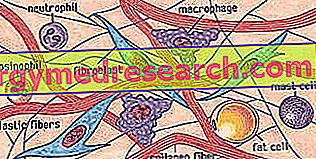Premise
It is said that the list of medicinal properties ascribed to grapes is as long as its varieties are: in fact, precisely because of its peculiar nutritional and chemical composition, grapes are exploited in the food, phytotherapeutic and cosmetic sectors.
Before developing in depth all the therapeutic properties ascribed to grapes, a nod to its nutritional values is a must, which will help us later to understand why grapes, in some ways, can be considered a miracle of nature.

Grapes: nutritional analysis
100 grams of fresh grapes bring about 61 Kcal: water is an abundant quantity (approx. 80.3%), carbohydrates - above all fructose and glucose - are estimated at around 15.6%, fiber amounts at 1.5%, 0.5% proteins and very few fats are only 0.1%.
As can be guessed from the large quantity of sugar, the consumption of grapes is not recommended for diabetics.
Grapes are rich in mineral salts, in particular potassium (192 mg / 100g); present, albeit in less important quantities, also manganese, copper, phosphorus and iron.
Among the vitamins of grapes can not miss the C (6 mg%), B1, B2, PP and A.
Properties of grapes
To give an immediate idea about the phytotherapic importance of grapes, just compare each of its berries and each of its leaves to a mini-pharmacy! The grape, in fact, is thirst-quenching and purifying and at the same time nutritious, energetic and mine of therapeutic virtues.
As we have seen, due to the considerable sugar intake, grapes are not recommended for diabetics; moreover, the consumption of grapes is not suitable for children - especially below the age of four - due to the high content of cellulose (skin), responsible for a possible difficult digestion.
In general, grapes are used mainly in the clinical and functional manifestations of the venous system (haemorrhoids, capillary fragility and venous insufficiency of the lower limbs), in the treatment of phlebitis, and as a natural remedy for bleeding (due to astringent properties) and for disorders related to menopause (species in synergy with other vasculotropic drugs). The fresh sap, appropriately diluted, acts as an eye drop and is also used to treat leeks and warts.
Now let's see in more detail which therapeutic properties are associated with each individual chemical component.
The anthocyanosides, contained in the vine leaves, exert angioprotective activities: they reduce the permeability of the capillaries and increase their resistance. Still, in the leaves Proantocianidoli are found, able both to strengthen the angioprotective activity, and to favor a pressure depotentiation.
The procyanidins - catechinic tannins contained in the leaves - exert an antimutagenic effect (related to the antioxidant activity), useful for preventing skin aging and chronic-degenerative diseases; in a similar way, procyanidins exert a mild enzyme inhibition, favor the correct functioning of the peripheral vascular system and, lastly, have good potential for improvement at the ophthalmic level.
Grapeseed oil is rich in polyunsaturated fatty acids; consequently, it exercises a laxative (lubricant) and cholesterol-lowering action. Sweet almond oil surrogate, for external use, it performs mostly emollient properties; the grapeseed oil, associated with the anthocyanosides of the leaves, contributes to the vasoprotective action, giving elasticity to the skin (ability to stabilize elastin and collagen).
Proanthocyanidins are mainly found in the seeds of purple grapes: these have strong antioxidant properties, therefore useful as an adjunct to chemo therapies in cancer patients (in particular, attenuation of side effects).
Resveratrol is a stilbenic compound found in particular in the roots of vines: this substance is useful in the prevention of cardiovascular diseases, as it improves the fluidity of the blood, thus decreasing the risk of possible platelet aggregation.

Polyphenols help keep the skin elastic, counteracting the degradation of collagen and elastin; they also promote the inhibition of LDL oxidation.
The mineral salts contained in the grapes are useful for the formation of hemoglobin, to stimulate the secretion of bile and to promote digestion; furthermore, the mineral salts act as a diuretic (potassium) and re-mineralizing.
Vitamins carry out antioxidant and vitaminizing properties.
Finally, red grape seed oil has an angioprotective and inhibitory potential of the enzyme that converts angiotensin. [properties taken from Ragionicist dictionary of herbalists and phytotherapy, by A. Bruni, M. Nicoletti and Dizionario di phytotherapy and medicinal plants, by E. Campanini]
Grape in syrup
X Problems with video playback? Reload from YouTube Go to Video Page Go to Video Recipes Section Watch the video on youtubeList of active ingredients
Given the complexity of the active ingredients that characterize the phytocomplex extracted from grapes (leaves, seeds and fruit), the table summarizes the key points, highlighting the molecule considered, the part of the plant from which it is derived and the medicinal function performed at body level.
| Molecule | Part of the plant | Function | Short description |
| anthocyanosides | leaves | Angioprotettrice | Decreased capillary permeability, increased resistance |
| Proantocianidoli | leaves | Angioprotective and hypotensive | Strengthens the angioprotective activity and promotes a pressure reduction |
| procyanidine | Catechinic tannins contained in the leaves | anti-mutagen Antioxidant Enzymatic inhibition Ophthalmic | → antimutagenic effect related to antioxidant activity, prevents skin aging and chronic-degenerative diseases → enzymatic inhibition → favors the correct functioning of the peripheral vascular system → good potential for improvement at the ophthalmic level |
| Polyunsaturated fats | Grapeseed oil | laxative cholesterol lowering | Acts laxative (volume) and cholesterol-lowering |
| Oil | Grape seeds | Emollients | Sweet almond oil substitute |
| Anthocyanosides + essence (oil) | leaves | vasoprotector | They contribute to the vasoprotective action, giving elasticity to the skin (ability to stabilize elastin and collagen) |
| proanthocyanidins | Purple grape seeds | Antioxidant | Useful as an adjunct to chemo therapies in cancer patients (in particular, mitigating side effects) |
| Resveratrol, stilbenic compound | Vine roots | Antioxidant | Prevention of CVL diseases |
| Polyphenols | Antioxidant | They help keep the skin elastic They help inhibit LDL oxidation | |
| Mineral salts | Fruit | Diuretic and remineralizing | Useful for hemoglobin formation |
| Vitamins | Fruit | Antioxidants and vitamins | |
| Oil | Red vine seeds | Angioprotettrici | Angioprotectivis and inhibitors of the enzyme that converts angiotensin |
Grape care
More than a cure, we should talk about the grape diet: it is an ideal diet to purify the body from excess slag, also very useful to counteract cellulite and water retention.
Grape care can be performed when the fruit has reached the right degree of ripeness: the diet can be made with grape juice (which must always be very fresh), fruit with peel and seeds.
In scientific terms, the cure of grapes is ampelotherapy : a diet based on the elusively (or almost) basis of grapes. The cardinal goal is the detoxification of the organism: the care of the grapes should not last more than 2-3 days, but can be repeated twice a month.
Grape care is not recommended for those suffering from ulcer, irritable bowel, high blood pressure, diabetes and kidney dysfunction.
In any case it is good to keep in mind that the grape is not miraculous, in the sense that it would be wrong to consider this fruit as the panacea for all ills: in association with a healthy and regular lifestyle, the grape is an excellent adjuvant for mitigate problems of various kinds.



